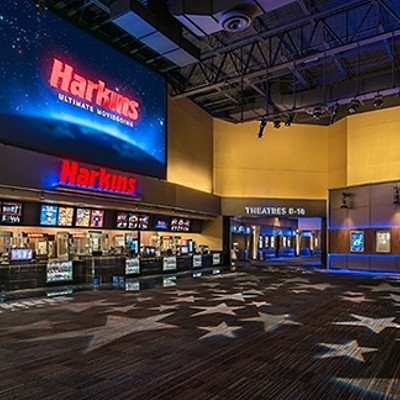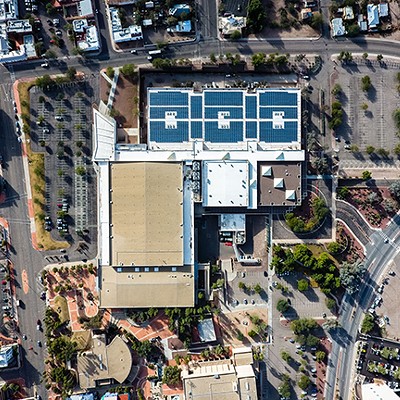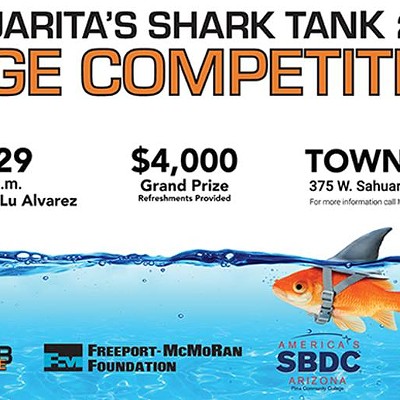Not likely. It isn't exactly Blade Runner we're living in here. Besides, I could still hear all my favorite '80s tunes day and night on satellite radio.
The future is rarely as spectacular as we want it to be, because prognosticators are usually thinking about the present while they're talking about the future. It's not surprising, then, that our recent economic woes and other issues of the day colored the answers I got when I asked several people a single question: "What will Tucson be like 25 years from now?"
These Tucsonans' jobs and avocations require them to think more about the future than most of the rest of us, and some of them believe the current recession will one day be seen as a before-and-after line in American history--as in, "This is how we lived before '08, and this is how we lived after." Nearly every expert talked about sustainability, and most believe that drastic, accelerated change is in store.
Then again, most felt at least a cautious optimism about the future, despite the rather gloomy tenor of the present.
RAY CARROLL
Pima County supervisor for District 4; Teddy Roosevelt Republican; he moved to Tucson 25 years ago from Chicago and promises to never leave.What we need less of in the next 25 years is growth hangovers. I think everybody who reads the Weekly understands that a joyful evening makes for a sad morning. We'll be living through one of the worst growth hangovers in the next two years that we are ever going to see. We need to realize that abundance versus moderation is not a choice--it's moderation. You can't have two paradises; you can't operate with all the fat luxuries of Southern Arizona as they are today and expect to have them and be able to call this paradise 25 or 50 years from now. As my uncle Carlos used to say, "It's a pay-us-now-or-pay-us-later issue." We need leaders out there who are willing to say that we have to give up some of these luxuries, and that it's going to cost us more to live here. We need less suffering in silence; we (elected officials) need to speak out and be role models, even if we are going to be despised because of it. And believe me, I've been there.
TRES ENGLISH
A well-known local community volunteer and activist since the early 1970s; currently director of Pima County's Teaching and Helping program and a member of Sustainable Tucson.The way I look at the world, we are living way beyond our means in every important respect. Twenty-five years from now, we will still be living beyond our means, but our means will be a lot less than they are today. We will simply have less stuff. We are at the beginning of a change that marks a new direction. Instead of getting our food from an average of 1,500 miles away, I expect, in 25 years, a quarter to a third of all the calories that we consume will be produced in Tucson. As a general principle, I would tell young people starting out right now to learn how to do a lot of different things (learn to feed yourself, clothe yourself, house yourself, fix your car, etc.)--have a diversity of skills; create a support network of the people around you; be friends with your neighbors.
ANDREW GUNNING
Director of planning, Pima Association of Governments; he obviously spends a lot of his time thinking about the future: On a table in his office, there was an artist's depiction of a futuristic-looking bullet train, painted in the colors of the Arizona flag, gliding through the desert.I think there are a number of things that are really going to start changing the dynamics in Tucson. I don't think gas is going to stay cheap; once we get out of this economic crisis, the cost of oil, of fossil fuels, is going to go back up to what we saw last year. We are still going to be driving 25 years from now, but our cars are going to be smarter: They will have better fuel efficiency and different energy sources--maybe being powered by renewable sources. We will see a lot more investment in transit over the next 25 years. I see our built environment evolving in a much better way in the future. We are going to change demographically as well; our population will get older, more diverse ethnically, and we are going to see a demand for different types of housing and different types of transportation. I see very positive things. It's not going to be easy; we are going to have to be willing to come together and deal with some of these tough issues, but in some ways, I see our quality of life maybe improving in the future."
PEGGY HUTCHISON
Executive director of the Primavera Foundation, a nonprofit that "promotes economic and social justice while working to build a future in which all people are assured basic human rights, a livable income and safe, affordable housing." Hutchinson has spent a lifetime working on poverty and human rights issues, and in the '80s was involved in Tucson's Sanctuary Movement.My perspective is more from a glass-half-full perspective; that's just who I am and how I live my life. I envision that there will be an awakening, a kind of renaissance, based on sustainability. Arizona is the state with the biggest gap between the rich and the poor, and I envision that will change. I envision that sustainability means that we won't have something like 25 percent of our population living in poverty. This financial crisis, from my perspective, at a very deep level, is happening because the way we live our lives is not sustainable. Right now, we have a few neighborhoods that are doing earthworks and other green projects. I envision 25 years from now, we'll have even more neighborhood and community associations, and a lot of the community-based organizations like Primavera, all of those will be incorporating earthworks and green technology in all of their projects, and all over town, there will be little green pocket parks and community gardens.
BRAD LANCASTER
Author of two award-winning books about rainwater harvesting; permaculture consultant; local leader in the sustainability movement. He keeps chickens in the yard of his small home near downtown, and collects hundreds of gallons of rainwater every year in a recycled septic tank.We've got a choice; it's really up to Tucsonans to determine what our future will be like in 25 years. We can either take the path to abundance or the path to scarcity. We are starting to take some great steps in the direction of the path to abundance. What does the path to abundance look like? We would be transforming both our individual and municipal landscapes so that they are irrigated primarily with rainwater--supplemented with household gray water and/or runoff from adjoining roads and so on--and moving away from the current paradigm, where municipal drinking water is the primary use of irrigated landscapes. Tucson is predicted to run out of water by about 2025. We are going to need 1,300 acre-feet per year in additional water; where's that going to come from? We can't get any more from the Colorado River; we will hit the maximum of our allocation at that time. Should we treat sewage? That's high-cost and poor water quality. Taking that path to abundance, I would see every household, every building in Tucson, harvesting rainwater within 25 years; that's feasible. If Tucson wants to be here in the next century, then we have to be in sustainable balance with our local water supply.
MARSHALL VEST
Director of the Economic and Business Research Center at the University of Arizona's Eller College of Management; for the last 25 years, he has been in charge of the college's Forecasting Project. He's the only person I interviewed who turned to a computer database to answer the question.In 2034, there will be about 1.6 million people here; that's another 600,000 people moving here in the next 25 years. The downturn is just temporary; my forecast now is that we will see the bottom in the second half of this year, then a modest recovery. We will start seeing some growth again in 2010, but it will probably be 2011 or 2012 before we will be back to normal. I think there's still a lot to be determined as to what the economy is going to look like 25 years from now. I can see it going one of two ways. We can become even more dependent on services and tourism, and in the process lose our manufacturing base, which isn't very big to begin with, and our export base could melt away. Or we could become established as a center for high-tech, solar research, biotechnology and all of the research involved in that. I think Tucson's strength today is (research and development), because of the university and a few employers like IBM that have their research and development operations here. Hopefully, (that research) will develop, and we will see more jobs in manufacturing. The complexity of the economy will certainly increase, as it has in the past. I think trade is going to increase, especially if we get a deep port in Guaymas (Sonora, Mexico).
BOB VINT
Principal architect, Vint and Associates; a native of Tucson and resident for nearly 50 years. He led the restoration of San Xavier del Bac; he wrote a book on Southwestern architecture for the Department of Housing and Urban Development; and he's been actively involved in downtown redevelopment issues for years.Much of Tucson is characterized by the suburban sprawl that's typical of Western American cities. Those are not the places that make Tucson what it is; it retains the charm it has because of its historic areas. This current economic downturn that we are just entering will certainly put the brakes on a lot of that sprawl development. Ironically, that's actually good for Tucson; it's not good for business or construction, or architects, but it's probably good for the city. The economic crisis is going to give impetus to inner-city development, because the suburban model of expansion is so inherently inefficient and expensive to maintain. I think in the best case, we will see reinvestment by property owners in inner-city properties, and infill housing developments of a high quality. I think the public will demand better design. I think the economic recession will make everything more competitive, and therefore, the quality will have to be higher. We are entering a period of time in Tucson that is unprecedented. This is going to be a long and severe recession, and ... it is going to force us to look at ways to live more economically, more efficiently. That will force us to return to the inner city and, block by block, redevelop it.












